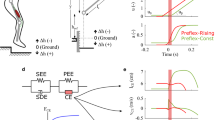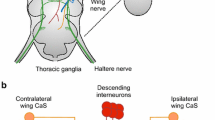Abstract
In a ‘muscle-specific’ flight simulator (simulator driven by muscle action potentials) locusts (Locusta migratoria) show motor learning by which steering performance of the closed-loop muscles is improved. The role of proprioceptive feedback for this motor learning has been studied. Closed-loop muscles were cut in order to disable proprioceptive feedback of their contractions. Since there are no proprioceptors within the muscles, this is a muscle-specific deafferentation. Cut muscles are still activated during flight and their action potentials can be used for controlling the flight simulator. With cut muscles in closed-loop, steering is less reliable as can be seen from the frequent oscillations of the yaw angle. However, periods of stable flight indicate that ‘deafferented’ muscles are still, in principle, functional for steering. Open-loop yaw stimuli reveal that steering reactions in cut muscles are weaker and have a longer delay than intact muscles. This is responsible for the oscillations observed in closed-loop flight. Intact muscles can take over from cut muscles in order to re-establish stable closed-loop flight. This shows that proprioceptive mechanisms for learning are muscle specific. A hypothetical scheme is presented to explain the role of proprioception for motor learning.
Similar content being viewed by others
References
Büschges A, Pearson K (1991) Adaptive modifications in the flight system of the locust after removal of wing proprioceptors. J Exp Biol 157:313–333
Heisenberg M, Wolf R (1988) Reafferent control of optomotor yaw torque in Drosophila melanogaster. J Comp Physiol A 163:373–388
Marsden CD, Rothwell JC, Day BL (1984) The use of peripheral feedback in the control of movement. Trends Neurosci 7:253–257
Möhl B (1988) Short-term learning during flight control in Locusta migratoria. J Comp Physiol A 163:803–812
Möhl B (1989) ‘Biological noise’ and plasticity of sensorimotor pathways in the locust flight system. J Comp Physiol A 166:75–82
Möhl B (1991a) Motor learning in the locust flight system requires proprioceptive feedback. Naturwissenschaften 78:84–87
Möhl B (1991b) Simulation of a model for motor learning in locust flight control. In: Elsner N, Penzlin H (eds) Synapse, transmission, modulation. Proceedings of the 19th Göttingen Neurobiology Conference. G Thieme, Stuttgart New York, p 87
Möhl B, Bacon J (1983) The TCG wind-sensitive interneurone in the locust. II. Directional sensitivity and role in flight stabilisation. J Comp Physiol 150:453–465
Möhl B, Nachtigall W (1978) Proprioceptive input on the locust flight motor revealed by muscle stimulation. J Comp Physiol 128:57–65
Ramirez M, Pearson K (1991) Octopaminergic modulation of interneurons in the flight system of the locust. J Neurophysiol 66:1522–1537
Robert D (1988) Visual steering under closed-loop conditions by flying locusts: flexibility of optomotor response and mechanisms of correctional steering. J Comp Physiol A 164:15–24
Rowell CHF (1988) Mechanisms of flight steering in locusts. Experientia 44:389–395
Schildberger K, Huber F (1988) Post-lesion plasticity in the auditory system of the cricket. In: Flohr H (ed) Post-lesion neural plasticity. Springer, Berlin Heidelberg New York, pp 565–575
Schmitz B (1989) Neuroplasticity and phonotaxis in monaural adult female crickets (Gryllus bimaculatus de Geer). J Comp Physiol A 164:343–358
Taylor CP (1981) Contribution of compound eyes and ocelli to steering of locusts in flight. J Exp Biol 93:1–32
Thüring DA (1986) Variability of motor output during flight steering in locusts. J Comp Physiol A 156:655–664
Wolf R, Heisenberg M (1990) Visual control of straight flight in Drosophila melanogaster. J Comp Physiol A 167:269–283
Wolf R, Heisenberg M (1991) Basic organization of operant behavior as revealed in Drosophila flight orientation. J Comp Physiol A 169:699–705
Zarnack W, Möhl B (1977a) Activity of the direct down-stroke flight muscles of Locusta migratoria (L.) during steering behaviour in flight I. Patterns of time shift. J Comp Physiol 118:215–233
Zarnack W, Möhl B (1977b) A data aquisition processor with data reduction for electrophysiological experiments. Fortschr Zool 24:321–326
Author information
Authors and Affiliations
Rights and permissions
About this article
Cite this article
Möhl, B. The role of proprioception for motor learning in locust flight. J Comp Physiol A 172, 325–332 (1993). https://doi.org/10.1007/BF00216614
Accepted:
Issue Date:
DOI: https://doi.org/10.1007/BF00216614




